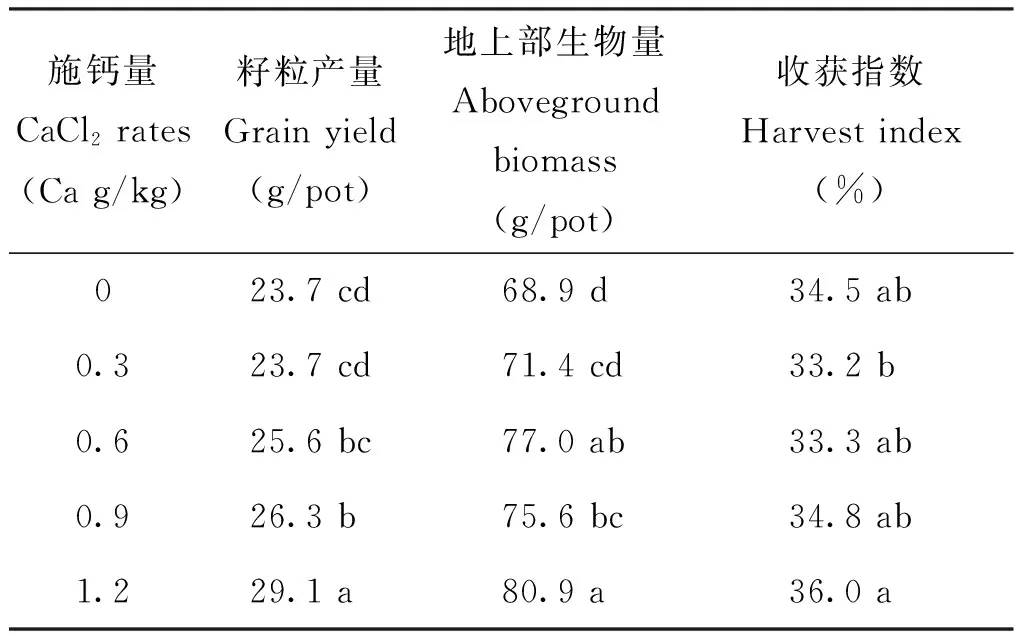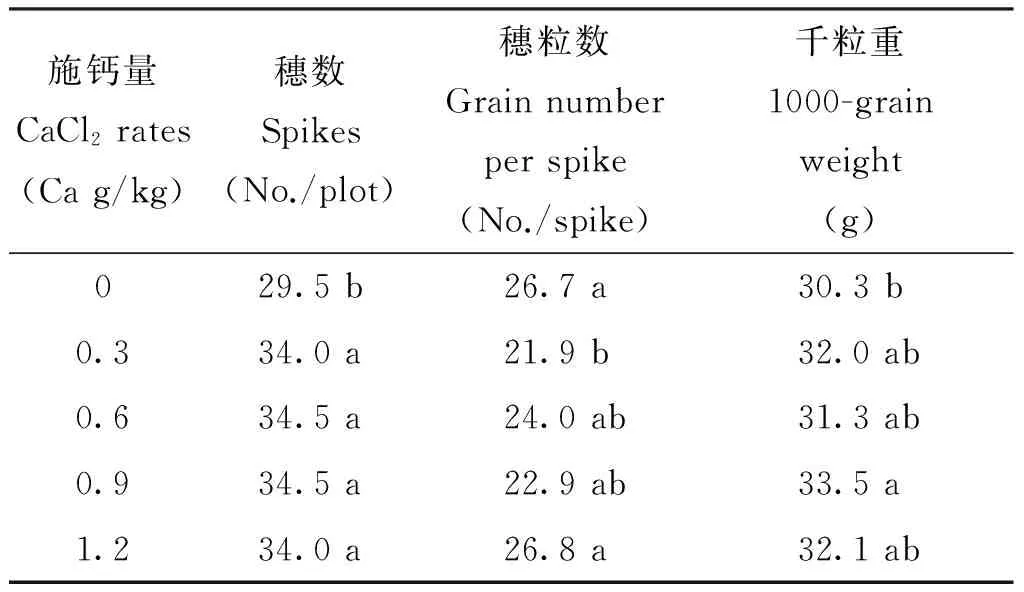石灰性土壤施用氯化钙对冬小麦生长及钙锌吸收的影响
高雅洁, 王朝辉,2*, 王 森, 靳静静, 曹寒冰, 戴 健, 于 荣
(1 农业部西北植物营养与农业环境重点实验室/西北农林科技大学资源环境学院,陕西杨凌 712100;2 旱区作物逆境生物学国家重点实验室/西北农林科技大学,陕西杨凌 712100)
石灰性土壤施用氯化钙对冬小麦生长及钙锌吸收的影响
高雅洁1, 王朝辉1,2*, 王 森1, 靳静静1, 曹寒冰1, 戴 健1, 于 荣1
(1 农业部西北植物营养与农业环境重点实验室/西北农林科技大学资源环境学院,陕西杨凌 712100;2 旱区作物逆境生物学国家重点实验室/西北农林科技大学,陕西杨凌 712100)

冬小麦; 锌; 钙; 石灰性土壤

我们于2009年至2010年进行的前期试验研究发现,在石灰性土壤上施入氯化钙,小麦籽粒锌含量可由对照的35.3 mg/kg提高到53.6 mg/kg,但籽粒钙及其他养分含量没有显著变化。为什么在石灰性土壤上施用氯化钙可提提高小麦籽粒的锌含量?是其改变了影响土壤锌有效性的因素,提高了土壤锌的有效性,还是促进了小麦对锌的吸收或向籽粒的转移?针对这一现象,我们继续以冬小麦为供试作物,设计了不同氯化钙用量的土培试验,通过研究土壤的pH, 钙、 锌有效性变化,冬小麦的干物质累积与转移、产量构成,作物的钙锌吸收利用,探讨石灰性土壤上施用氯化钙冬小麦增产和籽粒锌含量提高的原因,为活化土壤锌,促进作物对土壤锌的吸收利用,提高作物营养品质,改善人体健康提供依据。
1 材料与方法
1.1 供试土壤
供试土壤选自西北农林科技大学农作一站麦田耕层0—20 cm的土壤。将其风干、研碎,全部过10 mm筛,并将过筛的土壤充分混合均匀。供试土壤基本理化性状为: 有机质13.62 g/kg、 全氮0.86 g/kg、 硝态氮4.32 mg/kg、 铵态氮2.27 mg/kg、 有效磷(Olsen-P)14.6 mg/kg、 速效钾130.4 mg/kg、 交换性钙31.75 g/kg、 有效锌0.64 mg/kg、 pH值8.15。
1.2 试验设计

1.3 样品采集
在收获期(2011年5月27日)采集小麦植株样品。采样前先记录小麦每盆总穗数和总株数。采用不锈钢剪刀将穗剪下,用于考种,记录穗数,穗粒数,千粒重。再将小麦从根茎连接处剪下,并将盆中的脱落叶片全部收集,避免样品损失。

1.4 测定指标与方法
小麦茎叶、穗部样品称鲜重后,置于烘箱内先在105℃下杀青30 min,然后65℃烘至恒重,用以计算小麦地上部生物量。穗烘干称重后手工脱粒,分为籽粒和颖壳两部分,称量每盆籽粒烘干重,即为每盆籽粒产量;数每盆总粒数,用以计算穗粒数和千粒重(以烘干重表示)。
取部分茎叶、颖壳和籽粒样品,用去离子水清洗后,105℃杀青30 min,65℃烘干至恒重。用不锈钢剪刀将烘干后的茎叶、颖壳样品分别剪至0.5 cm长的小段,籽粒不做处理。植物样品用HNO3-H2O2微波消解仪(屹尧WX-8000,中国)消解,原子吸收分光光度计(日立Z-2000,日本)测定消解液中的钙、锌,计算植物钙、锌的含量,以烘干重表示。
风干土壤用四分法分成两部分,一部分磨细,过 1 mm尼龙网筛,用于测定土壤DTPA-Zn含量,用pH计以2.5 ∶1水土比,测定土壤pH。另一部分过0.25 mm尼龙筛,用于测定土壤交换性钙含量。土壤交换性钙采用1 mol/L乙酸铵溶液浸提,火焰原子吸收法进行测定。有效态锌采用DTPA溶液(DTPA 0.005 mol/L、 CaCl20.01 mol/L、 TEA 0.1 mol/L,pH=7.3)浸提,液土比为2 ∶1,原子吸收分光光度计测定浸提液中的锌含量。计算土壤交换性钙、有效锌的含量,以风干土重表示。
1.5 数据处理
采用Excel 软件对试验数据进行处理;采用DPS软件进行方差分析,多重比较用LSD 法,显著性水平设定为α=0.05。文中的相关参数及其计算公式[13-15]:
钙收获指数指籽粒的钙吸收量占作物地上部总钙吸收量的百分比, 即钙收获指数(%)=籽粒钙累积量(g/plot)/地上部钙累积量(g/plot)×100;锌收获指数指籽粒的锌吸收量占作物地上部总锌吸收量的百分比, 即,锌收获指数(%)=籽粒锌累积量(g/plot)/地上部锌累积量(g/plot)×100。
2 结果与分析
2.1 冬小麦籽粒产量、地上部生物量及收获指数
收获期的测定(表1)表明,小麦籽粒产量随氯化钙用量升高而增加。施Ca 0.9和1.2 g/kg时籽粒产量较对照显著提高10.7%和22.7%,施Ca 0.6、0.9和1.2 g/kg时地上部生物量分别较对照显著提高11.9%、9.8%和17.5%,但不同氯化钙用量的收获指数与对照相比均无显著变化。说明适量施用氯化钙能明显增加籽粒产量,增产的主要原因是促进小麦干物质形成,但并未能明显提高干物质向小麦籽粒的转移。

表1 施用氯化钙对冬小麦籽粒产量、地上部生物量及收获指数的影响
注(Note): 同列数据后不同小写字母表示LSD检验在P<0.05水平上差异显著 Values followed by different lowercase letters in the same column are significantly different atP<0.05(LSD test).
2.2 冬小麦穗数、穗粒数和千粒重
冬小麦产量三要素对氯化钙用量增加的反应不一致。施用氯化钙提高了穗数、千粒重,对穗粒数无显著影响(表2)。在施Ca 0.3 g/kg 时穗数显著增加15.3%,进一步增加氯化钙用量变化不显著。千粒重在施钙量达0.9 g/kg 时显著提高10.5%,而进一步增加氯化钙用量, 千粒重反而有所降低,但与对照差异不显著。由小麦产量三要素看,穗数和千粒重的增加导致了小麦产量提高,其中穗数提高更为明显,千粒重只有在氯化钙用量较高时变化显著。

表2 施用氯化钙对冬小麦穗数、穗粒数和千粒重的影响
注(Note): 同列数据后不同小写字母表示LSD检验在P<0.05水平上差异显著 Values followed by different lowercase letters in the same column are significantly different atP<0.05(LSD test).
2.3 冬小麦茎叶、颖壳和籽粒钙含量
小麦成熟期茎叶、颖壳、籽粒中钙含量对氯化钙用量的反应也不相同(表3)。小麦不同部位的钙含量表现为茎叶>颖壳>籽粒。茎叶钙含量在施Ca 0.9和1.2 g/kg 时分别较对照提高了53%和68%,差异达显著水平。颖壳钙含量在施Ca 0.6 g/kg时显著增加34%,增施Ca达0.9和1.2 g/kg, 颖壳钙含量继续增加,较对照分别显著提高36%和51%。小麦籽粒钙含量虽有一定程度的增加,但差异未达显著水平。可见,施用氯化钙显著提高了小麦茎叶和颖壳中的钙含量。
2.4 冬小麦地上部钙累积量、籽粒钙累积量及钙收获指数
对冬小麦钙累积量的分析(表4)表明,小麦钙累积量随氯化钙用量增加而增加。其中籽粒钙累积量在施Ca 1.2 g/kg时,显著提高51.9%;地上部钙累积量在施钙0.3 g/kg时即已显著提高38.6%,且随氯化钙用量增加继续提高。钙收获指数反映钙在小麦营养器官和籽粒的分配情况,但随氯化钙用量增加,钙收获指数变化无明显趋势。可见,籽粒钙累积量的增加落后于地上部钙累积量的增加,说明施钙促进了小麦对钙的吸收,但难以促进钙由茎叶向籽粒的分配与转运。

表3 施用氯化钙对冬小麦各部位钙含量的影响(mg/kg)
注(Note): 同列数据后不同小写字母表示LSD检验在P<0.05水平上差异显著 Values followed by different lowercase letters in the same column are significantly different atP<0.05(LSD test).

表4 施用氯化钙对冬小麦钙累积量及钙收获指数的影响
注(Note): 同列数据后不同小写字母表示LSD检验在P<0.05水平上差异显著 Values followed by different lowercase letters in the same column are significantly different atP<0.05(LSD test).
2.5 冬小麦茎叶、颖壳和籽粒锌含量
对于小麦不同器官的锌含量测定表明,小麦成熟期籽粒、颖壳、茎叶中锌含量随氯化钙量增加而提高(表5),但器官不同增加情况也不同。施Ca 0.9和1.2 g/kg,茎叶锌含量高于对照,但差异未达显著水平,颖壳锌含量较对照分别显著提高40%和59%,籽粒锌含量分别显著提高25%和23%。可见,施用一定量的氯化钙,提高了小麦颖壳和籽粒中的锌含量,而对茎叶锌含量的影响未达显著水平。

表5 施用氯化钙对冬小麦各部位锌含量的影响
注(Note): 同列数据后不同小写字母表示LSD检验在P<0.05水平上差异显著 Values followed by different lowercase letters in the same column are significantly different atP<0.05(LSD test).
2.6 冬小麦地上部锌累积量、籽粒锌累积量及锌收获指数
随氯化钙用量的增加,小麦锌累积量不断增加(表6)。其中籽粒锌累积量在施钙 0.6 g/kg时显著提高15%,在施钙 1.2 g/kg时达到最大。地上部锌累积量也表现出同样的规律,在施钙 0.6、0.9和1.2 g/kg时,分别显著提高26.4%、36.4%和47.0%。锌收获指数虽呈现出增加趋势,但变化未达显著水平。表明在石灰性土壤上施用氯化钙能增强小麦对锌的吸收,并在一定程度上促进锌由茎叶向籽粒转运。

表6 施用氯化钙对冬小麦锌累积量及锌收获指数的影响
注(Note): 同列数据后不同小写字母表示LSD检验在P<0.05水平上差异显著 Values followed by different lowercase letters in the same column are significantly different atP<0.05(LSD test).
2.7 土壤交换性钙、有效锌和pH
对收获后土壤的测定(表7)表明,各处理间土壤交换性钙含量,土壤有效锌含量均无显著差异,但施钙 0.9和1.2 g/kg,收获时土壤pH分别由对照的8.16显著降低至7.93和7.97。

表7 施用氯化钙对土壤交换性钙、有效锌和pH的影响
注(Note): 同列数据后不同小写字母表示LSD检验在P<0.05水平上差异显著 Values followed by different lowercase letters in the same column are significantly different atP<0.05(LSD test).
3 讨论
3.1 小麦生长与籽粒产量
研究表明在交换性钙含量达到31.8 g/kg的石灰性土壤上,适量施用氯化钙能明显促进小麦干物质形成,增加籽粒产量,增产的主要原因是总生物量提高和穗数的增加。钙作为植物体内必需的营养元素,与植物生长发育的关系密切。禾谷类作物钙素缺乏会导致功能叶的叶尖及叶缘黄萎,植株未老先衰,结实少,秕粒多[16],从而使生物量和籽粒产量降低。

3.2 小麦钙的吸收利用
高交换性钙含量的石灰性土壤上,施用氯化钙没有提高收获期土壤交换性钙含量,但促进了小麦对钙的吸收,提高了成熟期茎叶和颖壳中的钙含量,但并未明显影响钙向籽粒的转运及籽粒钙含量。这与钙在营养器官茎叶中大量分布有关,说明茎叶对钙营养的增加更为敏感。田奇卓等[20]研究也表明小麦营养生长对钙的需求量超过生殖生长,拔节期生产100 kg干物质所需要的钙量最高为743.7g,其次为孕穗期614.3 g,而这时正是营养生长最旺盛的时期,此后随着生殖器官急剧增长,对钙的需求量反而有所减少。吴旭银等[21]对冀东地区晚播冬小麦的钙吸收特性的研究也发现,成熟期植株吸收的钙主要贮存在茎秆中,其次为叶片,分别占植株总吸收量的32.4%和25.1%。因此,小麦营养器官对钙营养增加的反应更为明显。本研究中小麦整株吸钙量在施氯化钙Ca 0.3 g/kg时即已显著增加38.6%,但籽粒钙累积量在氯化钙施用量增加到Ca 1.2 g/kg 时才显著高于对照,可见,保证茎叶充足的钙营养对维持和提高籽粒产量和钙吸收具有重要作用。
3.3 小麦锌的吸收利用


4 结论
盆栽试验条件下,石灰性土壤适量施用氯化钙能明显促进小麦干物质形成,增加籽粒产量;整株吸钙量随施钙量的提高显著增加,但不影响籽粒钙含量;施用氯化钙虽未明显提高土壤有效锌含量,但却显著降低了土壤pH,同时促进了小麦对锌的吸收以及向籽粒的转移。该结果虽发现于土培试验,但仍可为理解石灰性土壤中锌的活化机制,促进作物对锌的吸收利用提供参考。
[1] 李志军, 李平儒, 史银光, 张树兰. 长期施肥对关中塿土微量元素有效性的影响[J]. 植物营养与肥料学报, 2010, 16(6): 1456-1463. Li Z J, Li P R, Shi Y G, Zhang S L. Effects of long-term fertilizer management regimes on availability of soil micronutrient element[J]. Plant Nutrition and Fertilizer Science, 2010, 16(6): 1456-1463.
[2] Cakmak I. Enrichment of cereal grains with zinc: Agronomic or genetic biofortification?[J]. Plant and Soil, 2008, 302(1): 1-17.
[3] Ma G, Jin Y, Li Y et al. Iron and zinc deficiencies in China: what is a feasible and cost-effective strategy?[J]. Public Health Nutrition, 2008, 11(6): 632-638.
[4] 田霄鸿, 陆欣春, 买文选, 等. 碳酸钙含量对土壤中锌有效性和小麦锌铁吸收的影响[J]. 土壤, 2008, 40(3): 425-431. Tian X H, Lu X C, Mai W Xetal. Effect of calcium carbonate content on availability of zinc in soil and zinc and iron uptake by wheat plants[J]. Soils, 2008, 40(3): 425-431.
[5] 陆欣春, 陈玲, 田霄鸿, 等. 供锌条件下碳酸钙对小麦幼苗生长和锌吸收的影响[J]. 应用生态学报, 2006, 17(8): 1424-1428. Lu X C, Chen L, Tian X Hetal. Effects of CaCO3addition under Zn supply on wheat seedlings growth and Zn uptake[J]. Chinese Journal of Appllied Ecology, 2006, 17(8): 1424-1428.
[6] 张勇, 王德森, 张艳, 何中虎. 北方冬麦区小麦品种籽粒主要矿物质元素含量分布及其相关性分析[J]. 中国农业科学, 2007, 40(9): 1871-1876. Zhang Y, Wang D S, Zhang Y, He Z H. Variation of major mineral elements concentration and their relationships in grain of Chinese wheat[J]. Scientia Agricultural Sinica, 2007, 40(9): 1871-1876.
[7] 袁可能. 植物营养元素的土壤化学[M]. 北京: 科学出版社, 1983. Yuan K N. Soil chemistry of plant nutrient[M]. Beijing: Science Press, 1983.
[8] 周卫, 林葆. 土壤中钙的化学行为与生物有效性研究进展[J]. 土壤肥料, 1996,(5), 19-22. Zhou W, Lin B. Research progress on chemical behavior and bio-aviliablility of the calcium in soil[J]. Soil and Fertilizer, 1996,(5), 19-22.
[9] Prietzel J, Rehfuess K E, Stetter U, Pretzsch H. Changes of soil chemistry, stand nutrition, and stand growth at two Scots pine(PinussylvestrisL.) sites in Central Europe during 40 years after fertilization, liming, and lupine introduction[J]. European Journal of Forest Research, 2008, 127(1): 43-61.
[10] 刘合满, 张兴昌, 苏少华. 黄土高原主要土壤锌有效性及其影响因素[J]. 农业环境科学学报, 2008, 27(3): 898-902. Liu H M, Zhang X C, Su S H. Available zinc content and related properties of main soils in the Loess Plateau[J]. Journal of Agro-Envrionment Science, 2008, 27(3): 898-902,
[11] 买文选, 田霄鸿, 李生秀. 石灰性土壤小麦缺锌矫正及锌营养品质改善的途径[J]. 广东微量元素科学, 2007, 14(11): 1-10. Mai W X, Tian X H, Li S X. The pathways of rectification of Zn deficiency and improvement of zinc nutritional quality of wheat in calcareous soils[J]. Guangdong Trace Elements Science, 2007, 14(11): 1-10.
[12] Alloway B. Soil factors associated with zinc deficiency in crops and humans[J]. Environmental Geochemistry and Health, 2009, 31(5): 537-548.
[13] Gonzalez D, Obrador A, Lopez-Valdivia L, Alvarez J M. Effect of zinc source applied to soils on its availability to Navy Bean[J]. Soil Science Society of America Journal, 2008, 72(3): 641-649.
[14] Wang J, Mao H, Zhao H et al. Different increases in maize and wheat grain zinc concentrations caused by soil and foliar applications of zinc in Loess Plateau, China[J]. Field Crops Research, 2012, 135: 89-96.
[15] 樊堂群. 锌在不同基因型旱稻体内吸收运转差异的研究[D]. 青岛: 青岛农业大学硕士学位论文, 2005. Fan T Q. Studies on zinc uptake and translocation in different gentupic aerobic rice cultivars[D]. Qingdao: Ms thesis Qingdao Agricultural University, 2005.
[16] 曹恭, 梁鸣早. 钙—平衡栽培体系中植物必需的中量元素[J]. 土壤肥料, 2003,(2), 48-48. Cao G, Liang M Z. Calcium-an essential mid-element in balanced cultivation system[J]. Soil and Fertilizer, 2003,(2), 48-48.
[17] 林葆, 朱海舟, 周卫. 硝酸钙对蔬菜产量与品质的影响[J]. 土壤肥料, 2000, (2): 20-26. Lin B, Zhu H Z, Zhou W. Effects of Ca(NO3)2on yield and quality of vegetable[J]. Soil and Fertilizer, 2000, (2): 20-26.
[18] 伍素辉, 孙晶晶, 徐广. 硝酸钙对小麦叶片氮素代谢及产量的影响[J]. 麦类作物学报, 1999, 19(2): 53-55. Wu S H, Sun J J, Xu G. Effects of Ca(NO3)2on nitrogen metabolism and yield of wheat[J]. Journal of Triticeae Crops, 1999, 19(2): 53-55.
[19] 王学奎, 李合生, 刘武定, 等. 钙螯合剂对小麦幼苗氮代谢和干物重的影响[J]. 植物营养与肥料学报, 2000, 6(1): 42-47. Wang X K, Li H S, Liu W Detal. Effects of calcium chelator on the nitrogen metabolism and dry matter accummulation in wheat seedings[J]. Plant Nutrition and Fertilizer Science, 2000, 6(1): 42-47.
[20] 田奇卓, 贺明荣. 高产冬小麦钙, 镁元素吸收积累与分配规律的研究[J]. 河南农业大学学报, 1998, 32(2): 138-143. Tian Q Z, He M R. Study on uptake, accumulation and distribution of calium and magnesium in high yield winter wheat[J]. Journal of Henan Agricultural University, 1998, 32(2): 138-143.
[21] 吴旭银, 吴贺平, 李彦生, 等. 冀东晚播高产冬小麦京冬8号的钙镁硫吸收特性[J]. 麦类作物学报, 2001, 30(2): 20-23. Wu X Y, Wu H P, Li Y Setal. Assimilation Characters of Ca, Mg and S in late sowed high yield winter wheat Jingdong 8 in eastern Hebei Province[J]. Journal of Triticeae Crops, 2001, 30(2): 20-23.
[22] Kabata-Pendias A. Soil-plant transfer of trace elements-an environmental issue[J]. Geoderma, 2004, 122(2): 143-149.
[23] 蒋廷惠, 占新华, 徐阳春, 等. 钙对植物抗逆能力的影响及其生态学意义[J]. 应用生态学报, 2005, 16(5): 971-976. Jiang T H, Zhan X H, Xu Y Cetal. Roles of calcium in stress-tolerance of plants and its ecological significance[J]. Chinese Journal of Appllied Ecology, 2005, 16(5): 971-976.
[24] Kabata-Pendias A, Pendias H. Trace elements in plants and soils[M]. Boca Raton, Florida: The Chemical Rubber Company Press, 1984.
[25] Cakmak I, Marschner H. Enhanced superoxide radical production in roots of zinc-deficient plants[J]. Journal of Experimental Botany, 1988, 39(10): 1449-1460.
[26] Mclean E O. Calcium levels and availabilities in soils[J]. Commun Soil Science and Plant Analysis, 1975, 6, 219-232.
[27] 苏壮, 董翔云. 含氯化肥长期施用对土壤理化性质的影响[J]. 沈阳农业大学学报, 1997, 28(2): 116-119. Su Z, Dong X Y. Effects of long-term application of chlorine-containing frertllizers on soil physical and chemical properties[J]. Journal of Shenyang Agricultural University, 1997, 28(2): 116-119.
[28] 韦璐阳. 钙、 镁、 铁对土壤砷污染的治理研究[D]. 南宁: 广西大学硕士学位论文, 2005. Wei L Y. Study on prevention and control of arsenic toxicity by calcium, magnesium and iron[D]. Nanning: Ms thesis of Guangxi University, 2005.
[29] 徐茂, 王绪奎, 蒋建兴, 沈其荣. 江苏省苏南地区耕地利用变化特征及其对策[J]. 土壤, 2006, 38(6): 825-829. Xu M, Wang X K, Jiang J X, Shen Q R. Changes in cultivated land utilization pattern and countermeasures in South Jiangsu[J]. Soils, 2006, 38(6): 825-829.
[30] Zhang M K, He Z L, Calvert D, Stoffella P. Extractability and mobility of copper and zinc accumulated in sandy soils[J]. Pedosphere, 2006, 16(1): 43-49.
[31] 章明奎, 符娟林, 黄昌勇. 杭州市居民区土壤重金属的化学特性及其与酸缓冲性的关系[J]. 土壤学报, 2005, 42(1): 44-51. Zhang M K, Fu J L, Huang C Y. Chemical characteristics of heavy mentals and their relationships with acid buffer capacity of soils in residencial sites in Hangzhou City, Zhejiang Province[J]. Acta Pedologica Sinica, 2005, 42(1): 44-51.

Effects of calcium chloride on winter wheat yield and uptake of Ca and Zn in calcareous soil
GAO Ya-jie1, WANG Zhao-hui1,2*, WANG Sen1, JIN Jing-jing1, CAO Han-bing1, DAI Jian1, YU Rong1
(1KeyLaboratoryofPlantNutritionandAgri-environmentinNorthwestChina,MinistryofAgriculture/CollegeofNaturalResourcesandEnvironment,NorthwestA&FUniversity,Yangling,Shaanxi712100,China; 2StateKeyLaboratoryofCropStressBiologyinAridAreas/NorthwestA&FUniversity,YanglingShaanxi712100,China)
【Objectives】 The accumulation of calcium carbonate and higher pH in calcareous soil restrict the absorption of zinc(Zn) in wheat in northern China. However, because of highly exchangeable Ca contents in the calcareous soil, the research on crop calcium and zinc nutrition as well as their interaction usually was overlooked in this area. Therefore, a pot trial was carried out to investigate the effects of CaCl2on winter wheat growth, the uptake and utilization of Ca and Zn, and to explore the interaction between Ca and Zn in winter wheat. 【Methods】 The collected calcareous soil of 0-20 cm layer topsoil at the Experimental Station One at Northwest A&F University was used to cultivate winter wheat. The experiment with five treatments was designed by a randomized complete block design by four replications. The treatments included five Ca rates of 0, 0.3, 0.6, 0.9 and 1.2 g/kg soil, based on the application of nitrogen, phosphorus and potassium at N 0.3 g/kg, P2O50.2 g/kg and K2O 0.3 g/kg, respectively. A widely used local winter wheat cultivar of Xiaoyan 22 was used, and sowed on October 15 in 2010, and as basal application, all the fertilizers were completely mixed with the soil before sowing. Plant samples were collected at maturity stage to determine the dry weights of straw, glumes and grain of winter wheat, concentrations of calcium and zinc in these different tissues or organs, soil pH, soil exchangeable Ca and available Zn concentrations, and the uptake and harvest index of Ca and Zn by plants were evaluated. Data analysis was performed using Excel software, and analysis of variance was performed by DPS software. 【Results】 Data showed that grain yield and aboveground biomass of winter wheat increased with the application of CaCl2. The aboveground biomass in the treatments with supply of Ca 0.6, 0.9 and 1.2 g/kg significantly increased by 9.8% to 17.5%, and the grain yield in the treatments with supply of Ca 0.9 and 1.2 g/kg respectively increased by 10.7% and 22.7% relative to the control. Application of CaCl2significantly increased Ca concentration by 53% and 68% in wheat straw, respectively, when application rates were Ca 0.9 and 1.2 g/kg, and by 34%, 36% and 51% in glume, respectively when the rates of Ca 0.6, 0.9 and 1.2 g/kg were supplied compared to the control treatment. However, the Ca concentration in grain was not significantly changed. Total uptake of Ca increased significantly by 38.6% to 91.4% because of the increase in CaCl2application rates. The concentration of Zn in grains was significantly increased from 33.7 mg/kg in control to 42.0 and 41.6 mg/kg in the treatment with supply of Ca 0.9 and 1.2 g/kg, respectively. Total Zn uptake was also found to be significantly increased with an increase in CaCl2application rates, and was 47.0% higher in the treatment with supply of Ca 1.2 g/kg than that in the control. Application of CaCl2showed no obvious effects on the exchangeable Ca and available Zn in the soil at harvest stage, but the soil pH respectively decreased from 8.16 to 7.93 and 7.97 in the treatments with supply of Ca 0.9 and 1.2 g/kg compared to the control treatment. 【Conclusions】 Appropriate application of CaCl2in calcareous soil significantly increased the aboveground biomass and grain yield of winter wheat under pot experimental condition. Total Ca uptake significantly increased with the increase of CaCl2rates, whereas, the Ca concentration in grains was not affected. Application of CaCl2significantly decreased the soil pH at harvest stage, and simultaneously promoted Zn uptake and transportation in winter wheat, indicating that this study provides an useful information for the understanding on the mechanism of zinc activation and exploration in promoting the absorption and utilization of Zn by crops under calcareous soil condition.
winter wheat; zinc; calcium; calcareous soil
2014-03-10 接受日期: 2014-09-17 网络出版日期: 2015-05-14
现代农业产业技术体系建设专项资金(CARS-3-1-31);农业公益性行业科研专项经费项目(201303104, 201103003);农业科研杰出人才培养计划资助。
高雅洁(1988—),女,河北张家口人,硕士研究生,主要从事冬小麦锌及钙镁营养研究。 Tel: 029-87082234; E-mail: gyj06107048@163.com。 * 通信作者 Tel: 029-87082234; E-mail: w-zhaohui@263.net
S143.7+2; S512.1
A
1008-505X(2015)03-0719-08

